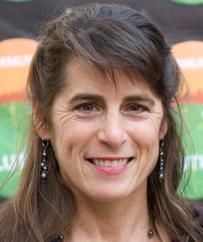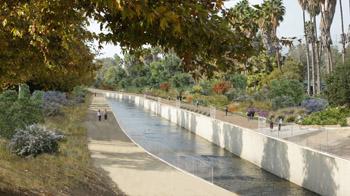Within the context of expanding access to the Los Angeles River for residents, Community Conservation Solutions (CCS) and the Santa Monica Mountains Conservancy are launching a project dedicated to LA County Supervisor Zev Yaroslavsky to create a half-mile section of trail along the river in the San Fernando Valley. This segment connects existing paths to form a five-mile continuous stretch. Esther Feldman, President of CCS, spoke with TPR to describe the greenway's scope, funding, and place within broader LA River revitalization efforts. Mia Lehrer, President of Mia Lehrer and Associates —a partner in the design process—commented on water management and plant selection, as well as benefits the trail will provide.

Esther Feldman
"By creating these linear greenways in the [San Fernando] Valley, we’re shining a spotlight on the need for river trails in other places around the county." -Esther Feldman

On November 1, County Supervisor Zev Yaroslavsky is being honored by Community Conservation Solutions and the Santa Monica Mountains Conservancy for his contributions to the funding of an important San Fernando Valley segment of the evolving LA River Greenway. Describe what’s being celebrated and its significance for Los Angeles.
Esther Feldman: Zev deserves the naming of this trail in the Valley not just because he played a critical role in funding this “missing link,” but also because of his many years of dedication and focus on making the LA River Greenway Trail in the San Fernando Valley a reality. We couldn’t be more pleased to be naming this important piece after Zev.
This particular segment will “bridge the gap” in the LA River Trail by connecting two fragments that already exist in the San Fernando Valley. It will create the longest LA River Greenway Trail in the Valley, at over five continuous miles.
The LA River clearly has become a Los Angeles cause célèbre in recent years. Numerous river projects now are being talked about and planned, with federal funding promised. What is the funding mix for this Greenway segment?
Esther Feldman: This is a classic example of putting together a lot of different puzzle pieces. One of the reasons building these river trails is so complicated is that many funding sources are necessary to make each project possible.
This LA River Greenway Trail section includes a combination of state and county funding. The state funding is from the CA Natural Resources Agency, mitigation funding from Caltrans to mitigate some of the damage done to habitat from the widening of the 405 Sepulveda Pass, and the Santa Monica Mountains Conservancy. The critical piece—almost half-a-million dollars—comes from Supervisor Zev Yaroslavsky’s discretionary Proposition A Regional Park and Open Space funds. There is private funding as well, including Community Conservation Solutions, and all of our sub-contractors are contributing some of their time. The City of LA has also made a funding commitment, as has the Studio City Residents Association.
What about this project inspires these funders and collaborators, drawing them together?
Esther Feldman: First, as I mentioned, this river trail segment is the “missing link” in this part of the Valley. There is a 2.5-mile section of river trail that goes downstream from Whitsett Avenue, almost to the CBS Studios. A 2-plus mile section goes from Coldwater Canyon upstream. But there is nothing between Whitsett Avenue and Coldwater Canyon. That’s a problem. If you want to go for a walk or make a reasonable loop, you get stopped and have to turn around. Our LA River Greenway Trail links these segments together so you can keep going.
And that is the long-term goal for the LA River Greenway—to create a connected greenway trail all along the river’s entire 51-miles.
In addition, our LA River Greenway Trail links to this 400-car public parking garage, which is envisioned as the LA River Bicycle Hub and Parking Garage. I never thought in my professional career that I would get so excited about a parking garage!
But we all know that people drive in this county and certainly in this area of the Valley, so we need to plan for that. People need to be able to drive and get to the LA River. Every place else along the LA River in the Valley is already either completely built up to the river’s edge with commercial or residential development, or is sensitive habitat, like in the Sepulveda Basin. You can’t put any kind of regional public access in those places, nor would you want to—since you wouldn’t want to take out the natural habitat already there.
This site has a four-story garage that’s under-parked and opens up directly onto an improved section of the LA River Trail. It already has a handicapped-accessible ramp that gets you down to the river trail and a pedestrian bridge. It couldn’t be better! We already have in place the visitor-serving infrastructure that we need to link not just the LA River Trail together, but to provide connections to the city’s bicycle network and a regional river open-space amenity for people throughout the Valley. The garage can become a place where you can rent bicycles and take your family for a ride on the river trail, then go get lunch, ice cream, or coffee on Ventura Boulevard just a half-block away.
This LA River Greenway trail starts linking to Zev’s other favorite projects—the Tujunga Wash Greenway a bit downstream and eventually the Pacoima Wash Greenway—and begins to realize the vision of regional, connected river parkways. These would allow people to walk, ride their bikes, access public transportation, and have alternate routes to school. River parkways also create green networks of native habitat and open space. By linking these trail segments together, the LA River increasingly becomes an accessible, beautiful place where people can go, catch their breath, step away from urban congestion and noise, and be in a little bit of nature.
What additions to best practices along the river will this effort contribute?
Mia Lehrer: There are many best management practices in the lexicon of engineers that are not regularly deployed and implemented (despite the city being welcoming). Here, rather than pumping the water that falls on the site into a stormwater pipe that then pipes into the river, we’re actually capturing the water in a half-mile bioswale, slowing it down, and infiltrating.
Environmentally, the more plants we have, the more we can assume that the water quality moving into the river is cleaner—since the water gets slowed down, taken up by the extensive root systems of native plants, and filtered. This increased uptake and permeability is coupled with a unique native habitat restoration plan along the river. Usually we’ve done restoration around similar projects that is more adapted to the urban environment, focusing on the physical properties and beauty of the plants. Here, ecologist and habitat restoration specialist Margot Griswold has worked with us to choose and plant a variety of trees, shrubs and plants that are really of the area—a native plant palette. We think this will be unique and will start helping people understand the value of nature in the city.
Esther Feldman: And we’re not just planting native plants in an aesthetically pleasing design. We’re copying nature, using an ecosystem-based design to recreate actual habitats with the mixture of tall trees, medium-sized bushes, small plants, and grasses that are critical to attract the butterflies, insects, and birds that make a habitat diverse.
Esther, you personally have been involved in reimagining the Los Angeles River and executing on that vision for a quarter of a century. Please draw an arc for our readers from your early efforts through to this November 2014 celebration?
Esther Feldman: In 1994, when I was working with the Santa Monica Mountains Conservancy and the Trust for Public Land, I helped put in place the first acquisition of open space along the Los Angeles River, in Elysian Valley: Elysian Valley Gateway Park. At that time, the river was completely fenced off, although people had cut holes in the chain-link and you could sneak through. There were very few places where there was any trail.
We realized that we needed to create a spot where people could stand on a park next to the river and say, “This is what it is supposed to look like.” That was in 1994.
Fast-forward to now, and here we are with millions of people—not just in this county, but statewide and nationwide—recognizing that the Los Angeles River is an important place to restore. It’s a place people now go. We have miles and miles of trails. What a tremendous victory to fast forward 20 years and be putting a piece in place to create five continuous river-trail miles in the Valley.
We have a lot of pieces of the arc still to fill in, but we’re not arguing anymore about whether restoration should happen on the river or whether there should be open space, habitat, or trails there. We’re all talking about when—and how—we can get it done.
This tribute to Zev speaks volumes because he stood up and said, “Here is some of the money to make this happen. I understand that we need to make this missing link possible.”
Mia, could you comment on the benefits the trail will offer for the surrounding communities?
Mia Lehrer: The trail provides value from a health perspective. Because the river is de facto the one linear element that is on grade and connects many communities—north, south, east, and west—it has the potential to bring a live, work, and play vision to the corridor. It allows one to connect different communities with options for walking, jogging, and biking, providing for a healthier city and healthier community through public open space.
How does Zev’s Greenway Trail addition complement the Army Corps’ now-approved Alternative 20 and future plans for investment along the Los Angeles River?
Esther Feldman: This is the Valley’s piece. There has been a lot of attention on Alternative 20, which is a little ways downstream. That is an incredibly important stretch of the river with much larger open space. But let’s not forget that we’ve got well over 2 million people in the San Fernando Valley—and a tremendous number of people that don’t have access to cars and depend on public transportation. The Valley is one of the most park-poor places in the State of California, well below the averages that the National Recreation and Parks Association recommends: 6-10 acres of easily accessible open space for every 1,000 people.
By creating these linear greenways in the Valley, we’re shining a spotlight on the need for river trails in other places around the county.
I like to speak to the transformational aspects of nature. It never fails to amaze me when I walk along the LA River, and particularly this section, that it’s half a block from Ventura Boulevard—one of the busiest thoroughfares in the county. And yet, it is quiet and peaceful at the river. There you are, watching red tail hawks soar and egrets fly by, with ducks on the water. Last week a flock of western bluebirds migrated through.
From time immemorial, people have wanted to “come down to the river.” We’ve never lost that. By building these segments of river trails that connect, we really make it possible to “come down to the river.”
Who will be involved in the November 1 tribute to Zev and opening of the trail?
Esther Feldman: Representatives from Congressman Sherman’s office are coming, as is Assemblymember Nazarian, City Councilmember Krekorian, the next state senator of the district—Robert Hertzberg, LA Board of Public Works Commissioner Barbara Romero, and Colonel Kimberly Colloton of the US Army Corps of Engineers. Of course, Zev will be there. We expect nearly 100 people—and maybe more—from the surrounding communities to attend.
- Log in to post comments



